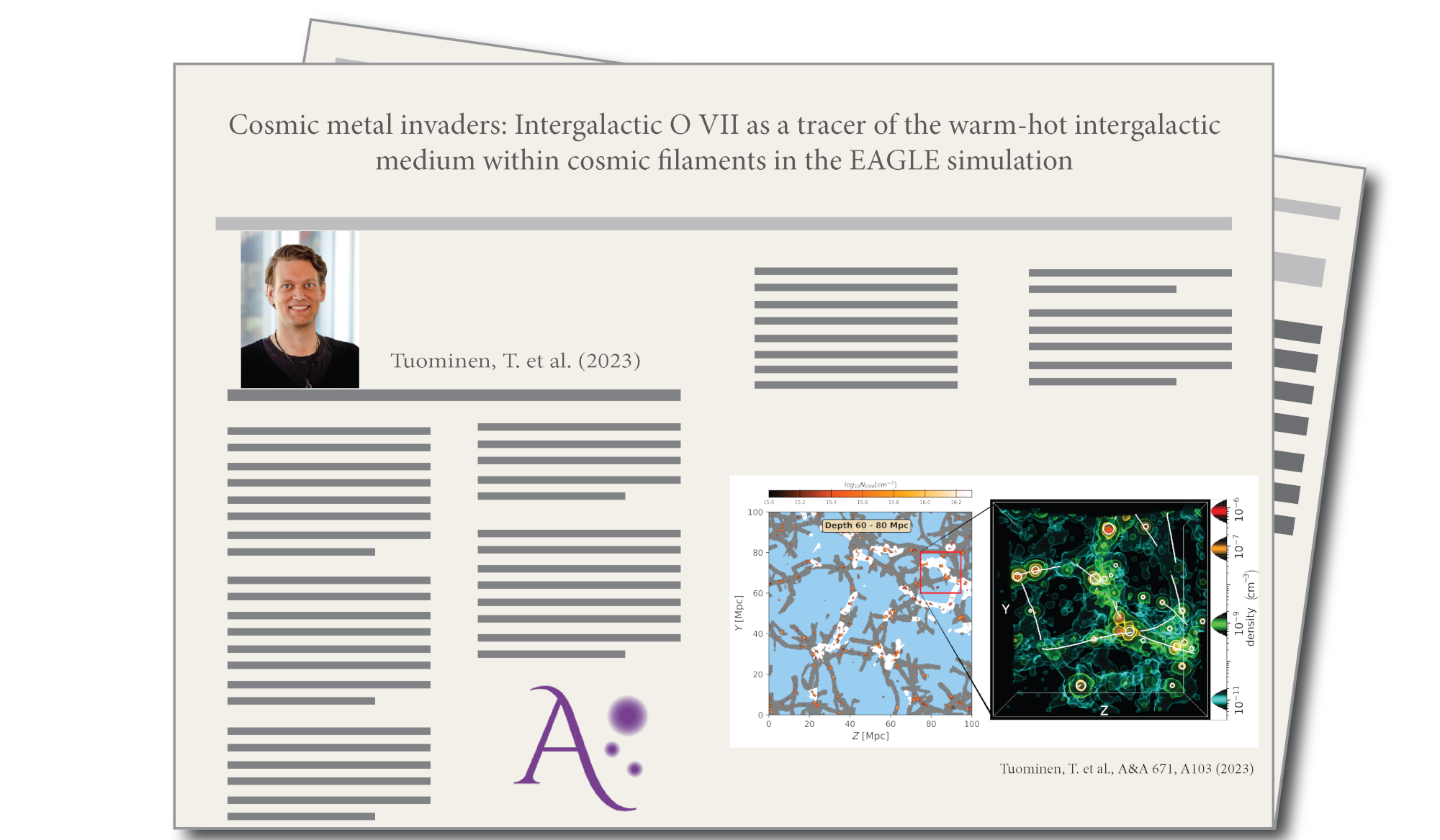
Cosmic metal invaders: Intergalactic O VII as a tracer of the warm-hot intergalactic medium within cosmic filaments in the EAGLE simulation

Inset figure caption: Comparison between the two-dimensional column densities and the three-dimensional number densities of O VII. Left: column densities of O VII projected through a 20 Mpc deep slice along the x-axis. Bisous filaments and high LD Bisous filaments are shown by grey and white areas, respectively. Right: three-dimensional visualisation of the O VII distribution in a (20 Mpc)^3 zoom-in box within the larger EAGLE volume. The white lines show the Bisous filament spines, while the white circles indicate the volumes within R200 around the central galaxies of the FoF haloes.
By Toni Kalevi Tuominen
The missing baryons is a problem whereby up to half of the baryons predicted by ΛCDM and constrained by Planck observations have not been detected in the nearby Universe. At the same time, hydrodynamical simulations suggest that half of the baryons at low redshift are within cosmic filaments in a warm-hot intergalactic medium (WHIM). This medium is very diffuse, with overdensities of δ ~ 10-100, and temperatures in the range log T(K) ~ 5-7. This combination of low density and high temperature is most likely the cause of the large fraction of baryons being undetected. As the bulk of the baryons are almost entirely ionised, direct observations of hydrogen are very challenging. Instead, highly ionised metals can be used as proxies to infer the total baryon density. In this manner, the gas at lower WHIM temperatures (log T(K) ~ 5-5.5) has been successfully traced by ions such as CIV and OVI in the far UV. On the other hand, the hotter end of the WHIM (log T(K) > 5.5) falls in the soft X-ray range, with OVII being the dominant ion.
The sub-keV ranges reachable by Athena/X-IFU will allow it to detect absorption signatures of OVII ions, potentially tracing the missing baryons in the intergalactic medium. Thus, to derive observational predictions for Athena, we studied the distribution of intergalactic OVII in the hydrodynamical EAGLE simulation. Moreover, we used the Bisous filament finding method to confirm that most of the OVII ions lie within cosmic filaments. The simulation indicates, however, that the filamentary OVII densities are very low, and tracing most of the missing baryons will remain challenging. Nonetheless, Athena/X-IFU will be able to probe gas up to a few virial radii, detecting the previously poorly measured circumgalactic medium (CGM) in the outskirts of galaxies. Furthermore, with future galaxy surveys (such as 4MOST) providing deep filament catalogues, the probability for Athena/X-IFU to detect an intergalactic OVII absorber within a known filament will be ~50% per pointing. Indeed, according to EAGLE, Athena/X-IFU will be
able to trace ≈25% of the previously poorly detected (i.e. missing) hot intergalactic medium, corresponding to ≈8% of the total baryon budget. Thus, with its excellent spectral capabilities, Athena/X-IFU will provide invaluable observations for reducing the amount of missing baryons.

